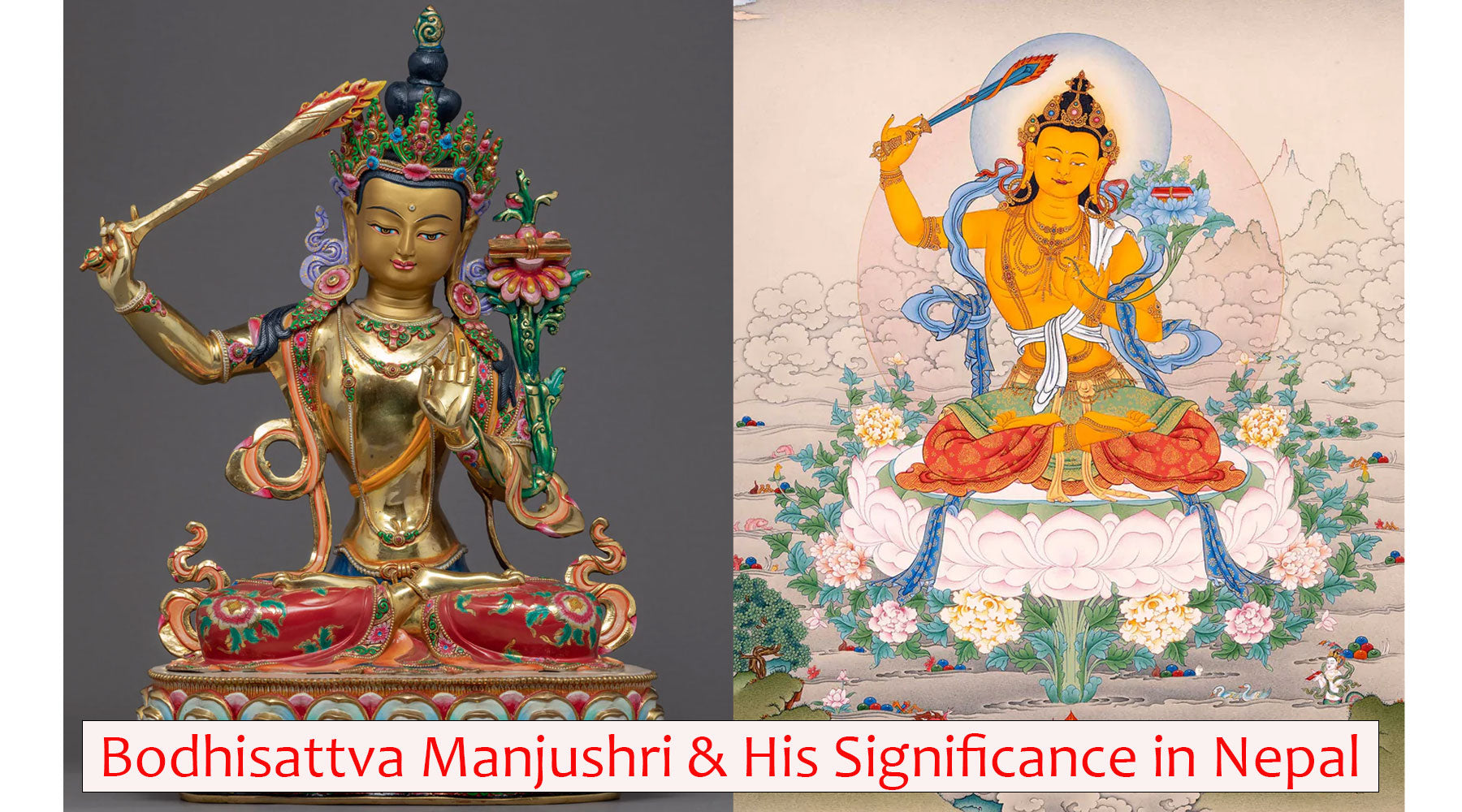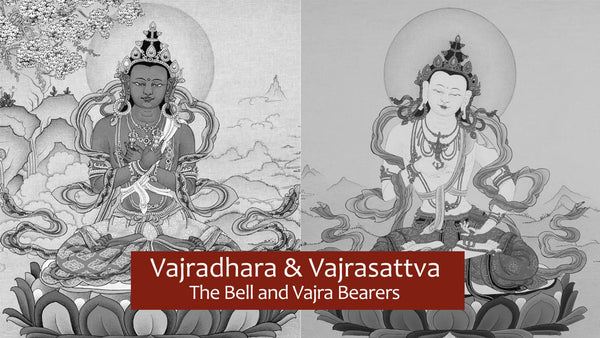The Bodhisattva of Wisdom, Manjushri
Manjushri is one of the oldest and most significant Bodhisattvas in Mahayana Buddhism. He is often referred to as Mañjuśrīkumarābhūta, Manjughosa, and Vagisvara. He represents the wisdom that is unhindered by concepts or opinions. He is revered as the "Meditational Deity" in esoteric Buddhism and referred to as "Prajna" in Sanskrit, which means "noble and gentle" and "He who is noble and kind." Mahayana Buddhism claims that he is the Bodhisattva with the utmost knowledge. 
View our High Quality Manjushri Thangka Paintings
Although Manjushri is generally considered a celestial bodhisattva, some individuals believe that he manifested on Earth. According to tradition, he was an incarnation of Vairocana, the monk who brought Buddhism to the former kingdom of Khotan. Atisa Dipankara, a Tibetan religious reformer active in the 11th century, was another manifestation of Manjushri. There are different forms of Manjushri as well.
Origin Story of Manjushri
Manjushri was born in northeastern China's Shanxi Province on Wu Tai Mountain. Avatamsaka Sutra has the first scriptural evidence for Manjushri's birth at Wu Tai Mountain in the chapter titled "Abodes of Bodhisattvas." It appears to be, "The Cool Mountain, where many Bodhisattvas from the past have lived, is a Bodhisattva residence in the northeast. It is the center for the worship of Manjushri Bodhisattva. It is believed that Manjushri Bodhisattva is currently residing there with 10,000 other Bodhisattvas who are his kin and to whom he frequently shares the Dharma."
The exact date when Manjushri entered the pantheon of the Northern Buddhists is still unknown. His name first appears in the Aryamanjushrimulakolpa, which is unquestionably a pre-Guhyasamaja work, and then again in the Guhyasamaja Tantra, believed to have been composed about the year 300 A.D. At least four references to Manjushri and three to Manjuvajra can be found in this book.
In the Sukhavati Vyuha, commonly known as the Amitayus Sutra, which was translated into Chinese between A.D. 384 and 417, his name is also mentioned in the minor recension 8 of the scripture. But Manjushri is frequently mentioned in later Buddhist texts. Different forms of Manjushri have been mentioned at different times.
Click here to read about Five Forms of Manjushri
Manjushri as Wenshu in China
Source: The Jade Turtle Records
Manjushri, the bodhisattva of knowledge and one of the several deities that played a part in Chinese Buddhism, is among the most enticing. In Chinese, his name is Wenshu. Manjushri, one of the three most significant bodhisattvas in East Asia, is said to have come from the highlands around Mount Wutai, a well-known Buddhist monastic site, in China. He was revered as the embodiment of wisdom and the protector of sacred teachings. He is typically shown as a young, jewel-encrusted prince who rides a lion while holding a book of truth and a sword that pierces through ignorance. He also frequently appears standing on two legs.
Here the lion is the king of the animal kingdom signifies the stern majesty of knowledge. Furthermore, it implies that Manjushri imparts Dharma without favoritism or fear.
From the Tang period (A.D. 618-907) onward, images of Manjushri riding a lion were common. In this form, he was most usually shown beside the bodhisattva Samantabhadhra, who stood on each side of the real Buddha Shakyamuni in a triad.
Manjushri as Monju in Japan
Source: Umma Exchange
The renowned deity Bodhisattva Manjushri is referred as Monju Bosatsu in Japan. Ennin (794–864 AD), a Japanese monk who traveled to China, encountered Wutaishan, a five-terraced peak in Shanxi Province, and brought Monju's devotion to Japan (838-847 AD).
Monju, which stands for knowledge and the enlightened mind (realization), is frequently coupled with Fugen Bosatsu, which stands for meditation and practice (praxis). In Japanese art, Monju and Fugen are frequently shown flanking the Historical Buddha in a formation known as the Shaka Trinity (Jp. = Shaka Sanzon), with Monju positioned to the left and Fugen to the right of the center Shaka figure. Monju is the Guardian of Wisdom (the voice of explication) in this grouping, while Fugen is the Guardian of the Law (the holder and practitioner of Buddhist Law).
The Swayambhunath Purana: Manjushri and Kathmandu Valley Lake
Manjushri is mentioned in several intellectual teachings by Shakyamuni Buddha. There are numerous references in several myths and tales from the time of Buddha that are still well-known today. The Kathmandu Valley in Nepal was emptied by Manjushri, making it suitable for human settlement. is one of the most prominent tales.
The Kathmandu Valley was originally a lake, as is clear from the region's geology. However, as geologists piece together the origins and end of the primordial lake, they now believe that it may not have been wholly emptied but drained out over time. The proto-Bagmati River was dammed and raised by tectonic uplift of the southern margin of the valley to create the lake over a million years ago, perhaps where Katuwal Daha is at present.
In the book 'History of Nepal' by Daniel Wright, it is mentioned that Manjushri traveled from Mahachin (China) and spent three nights resting on Mahamandap, a hill east of Bhaktapur, where he noticed the 'Swayambhu lights.' He wanted to get closer to the light, so he cut a gorge at Chobhar to drain the Nagdaha (lake of the spirited serpents). He positioned himself in the center, one of his two goddesses, Barda and Makshada, on Phulocha and the other on Dhyanchha respectively. He proceeded to cut the mountain, which he called Kotwal.
This drained the Kathmandu valley hence making it habitable. He then moved the lotus with the blue flame to the top of a steep hill in the freshly formed valley. The Swayambhunath stupa was eventually built there. Manjushri is regarded by the Nepalese as the founder of the Kathmandu Valley and its culture. The valley was then inhabited. Manjupattan is said to have been the name of the earliest human habitation in the Kathmandu valley.
The miraculous Swayambhu light was placed in a stupa as a memorial for future generations. One of Asia's most important pilgrimage destinations is still the Swayambhunath Stupa. The place has been visited by a lineage of great Buddhist gurus beginning with Shakyamuni himself.
After that, Manjushri built a temple over a fire and built his own home and a Vihara (or monastery) for his followers, now known as the Manjupattana, close by on a hill. Manjushree is credited with founding Manjupattana, most likely in or near the Balaju region. Later, it's capital was moved from the banks of Ikshumati to Sankasya (Tukucha).
Finally, he appointed Dharmakara as Nepal's king. The Swayambhu Purana attributes Manjushri with these and numerous other religious deeds. Manjushri returned home, put everything in its place, and shortly after, he attained the divine form of a Bodhisattva, leaving his human body behind.
From the above, it appears that Manjushri was an outstanding individual who introduced civilization from China to Nepal. He was a remarkable architect and reportedly had amazing engineering ability.
He significantly impacted Buddhist practitioners, and the Mahayana practitioners worshiped him in various ways and forms. Nearly every nation on the Asian continent where Buddhism was practiced is familiar to him. Manjushri plays a significant role in Tibetan Tantra and is frequently shown in Zen meditation areas. Manjushri is associated with poetry, oratory, and writing in addition to wisdom. He is believed to have a very melodic voice.



1 comment
Nabraj
“I have visited Swayambhunath Stupa many times. It is a very calming and sacred temple. Each visit leaves me feeling enlightened.”